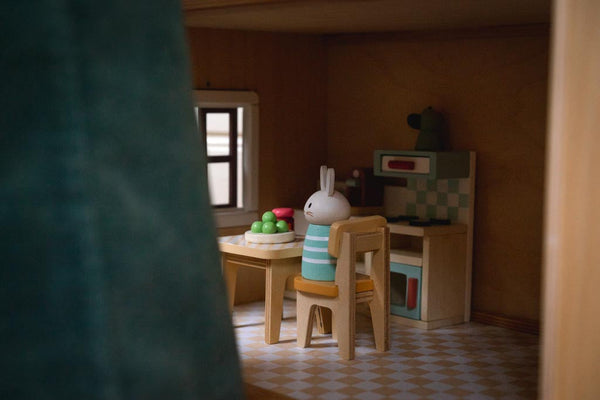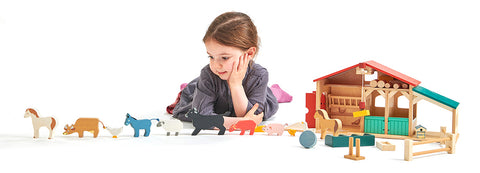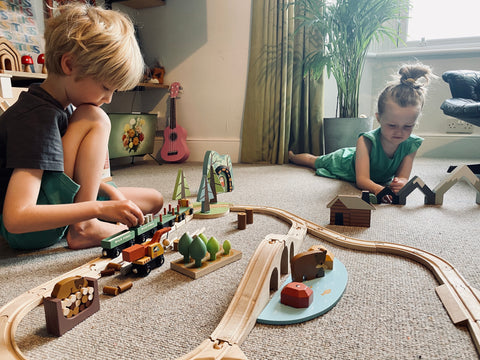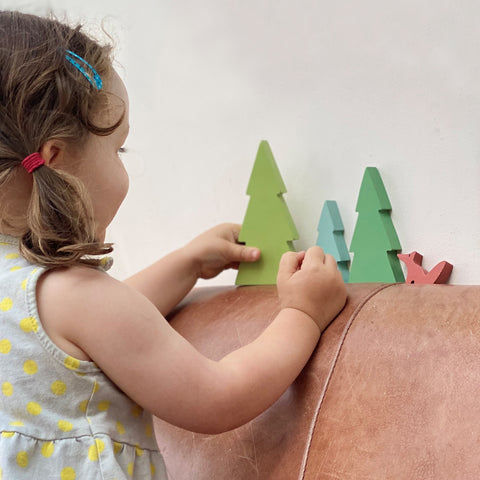Small world play | An early learning essential

Small world play
Who’s that trip trapping over my bridge?
Please don’t eat me. I’m only small. My big brother is coming along soon. He’s much better to eat.
A wooden toy goat in one hand, a farmer moonlighting as a troll in the other. Your child is playing make believe.
Our children use small world play to make sense of the world. They re-enact favourite stories, looking through the eyes of the characters and exploring situations that would be too dangerous to experience in real life.
Contents:
- What is small world play?
- A cast of characters for fairytale fun
- What are the best toys for small world play?
- Help your child see the possibilities with invitations to play
- Read more stories for better play
- Small world play for toddlers
- Final word

What is small world play?
Small world play involves children using small toys to act out scenarios from the real world or their imaginations.
You simply need some figures and a setting. The arm of a sofa or the shelf of a bookcase will both do just fine but sets like farms and castles can add depth to the story.
A cast of characters for fairytale fun
Look at your bookshelf. Do you have Aesop’s fables? A book of traditional tales?
Do you sing nursery rhymes to your child?
Over the years, she will have built up a cast of characters who can be drafted in to any story.
- Cinderella
- The Gingerbread man
- Goldilocks and the Three Bears
- Little Red Riding Hood
- The Three Billy Goats Gruff
- The Princess and the Frog
Your child learns that these characters symbolise something bigger, an idea, an archetype: A mother, a trickster, a protector.
She won't draft the littlest billy goat into a small world game about fairies and witches but she will bring the idea of a plucky underdog tricking a villain.
Before our children can detect subtle differences in character, they have to learn the stereotypes. Big bad wolves have to be bad and princes brave.
Of course, life is more subtle. And through small world play, your child will work this out for herself.
What happens if I have a cowardly prince and a fearless princess? What if the dragon is gentle and the fairy godmother a witch?
What's special about small world play is that it grows with your child. Toddlers enact familiar sequences from everyday life but preschoolers make believe. The toys are the same but the result is very different.
What are the best toys for small world play?
Choose figures that help you maximise the number of stories you can tell.
A toy farm with sheep, chickens and goats is fun. But a toy farm with a wolf is even better. Now add a brave farm dog and a wise old owl. The storytelling potential has grown exponentially.

Figures for small world play
What kind of world will you create? Somewhere happy and familiar or dark and threatening?
Who will live there? The figures you choose will set the scene. Aim for a mix of goodies and baddies.
Small world play sets
- Ark. A brilliant first small world set, especially as many double as a shape sorter, encouraging posting, positioning and rotating.
- Doll’s house. A place to re-enact the day's events and develop social and emotional intelligence.
- Farm. A doll's house for animals. Just like the members of your family, each animal has its own unique personality. Perfect for toddlers and younger preschoolers.
- Train set. A whole world in one loop of track. Where will your train go today?
- Wooden castles. What happens in a castle? Sieges and battles, royal weddings and coronations. There are treasure hoards and Castles have it all.
Small world play scenery
What's a small world without scenery? Bring yours to life with these simple sets:
- Trees
- Rivers
- Mountains
Help your child see the possibilities with invitations to play
Older children have well-developed imaginations. A pencil can be a puppy, a cereal box its kennel. But younger children need more help to see the play potential in toys.
This is where invitations to play come in.
An invitation to play can be many things but in this context we are talking about a small world scene that you have prepared in advance and now present to your child. Set up the farm, assemble the castle, place the figures in meaningful configurations. Your child will immediately see the story that is being told. The fox is in the hen house! The invaders have stormed the castle! It's easy to jump in and start playing when you can see what to do next.
Your 'invitation' is not a command. Your child is free to take the story in any direction she likes.
You can get as creative as you like. Bring in objects from around the house. You are creating a world for the characters to inhabit.
- House plants > forest
- Cushions > hills
- Blankets > rivers and seas
- Boxes > houses
You can even introduce craft materials. After playing wit the scene for a while, your child might decide to draw windows and doors on the cardboard box, or put cotton wool on top to signify snow.

Read more stories for better play
By sharing stories with your child, you inspire her play. The more stories she hears, the richer her imagination. With every fairy tale you read, you add another character to the roster of small world protagonists.

Small world play for toddlers
Small world play is fun. And it can be the answer to a long afternoon stuck at home with nothing to do. It keeps children busy for hours.
But, it doesn't work as you might expect with toddlers.
Toddlers are too young to be able to fully participate in imaginative play. They still need their toys to look like the things they represent. A fire engine must resemble a fire engine. A wooden block just won't do.
What this means for you is that invitations to play can go wrong.
Your child surveys the scene you created and leaps in excitedly. But instead of telling a story with Goldilocks, she posts the doll through the window of the house. Then the bears go through the same opening. Then the porridge and the chairs. And then your child goes round the back of the house to look at all her good work from another angle.
Your child is simply not at the right stage of development to tell complicated stories. She enjoys heuristic play - discovery play - where she likes to explore the properties of objects and seeing what they can be used for.
In other words, don't spend too long making a beautiful scene, perhaps adding sensory materials like sand and water. Your child will just make a mess.
It will be an educational mess, one that she enjoys and learns from, but it won't be small world play.
That's why wooden train sets are perfect for this age group. They teach the things young children are motivated to understand: in, out, along, through and across. They are the perfect bridge to small world play.

Final word
Small world play comes naturally to young children. But they have to be ready for it. Don't despair if your two-year-old is more interested in piling or sorting or posting the dolls than playing with them. It's a natural stage of her development. Keep the fancy set-ups for the preschool years when her imagination has matured.
Small world play is a skill to be mastered. The more stories you read and the more nursery rhymes you sing, the greater the store of characters and narratives your child can call on when she plays.
It's the key to organising thinking and learning to write.
It's essential play.








